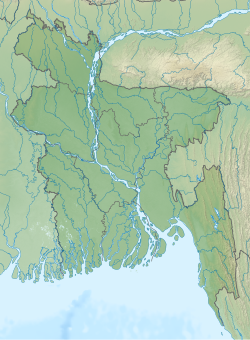Shahidi Mosque
Appearance
This article needs additional citations for verification. (August 2021) |
| Shahidi Masjid | |
|---|---|
শহীদী মসজিদ | |
 | |
| Religion | |
| Affiliation | Islam |
| Ecclesiastical or organizational status | Mosque |
| Status | Active |
| Location | |
| Location | Kishoregonj |
| Country | Bangladesh |
Location of the mosque in Bangladesh | |
| Geographic coordinates | 24°26′03″N 90°47′05″E / 24.4342°N 90.7848°E |
| Architecture | |
| Type | Mosque architecture |
| Minaret(s) | One |
The Shahidi Masjid (Bengali: শহীদী মসজিদ; Arabic: المسجد الشهيدي; lit. 'Martys' Mosque') is a three-storey mosque, located in the Kishoreganj District of Bangladesh.[1] A 5-storey minaret is attached to the mosque.[2]
History
[edit]The Friday mosque was previously known as the Jame Masjid. On 24 October 1942, in the midst of communal tensions, British Indian police fired on the mosque, killing several worshipers. The mosque was subsequently renamed as Shahidi Masjid, or the Martyrs' Mosque.[3][4]
In 1938, Athar Ali Bengali arrived to Kishoreganj where he rebuilt the mosque and served as an imam. In 1945, Ali established the Jamia Emdadia Madrasa in Kishoreganj on the premises of the mosque. He established the 5-storey minaret in 1957.[5]
See also
[edit]References
[edit]- ^ "Historical Shahidi Mosque". Kishoreganj District.
- ^ শহীদী-মসজিদ,-কিশোরগঞ্জ. Kishoreganj District (in Bengali). Archived from the original on 24 July 2021. Retrieved 24 September 2021.
- ^ Chatterjee, Chhanda (2020). Syama Prasad Mookerjee, the Hindu Dissent and the Partition of Bengal, 1932-1947. Routledge. ISBN 978-1-000-16378-0.
- ^ প্রতিষ্ঠাতা মুজাহিদে মিল্লাত হযরত মাওলানা আতহার আলী (রহঃ) এর সংক্ষিপ্ত জীবনালেখ্য. www.aljamiatulimdadia.org.bd (in Bengali).
- ^ "Memoir of the Graduates of the Dar al-Ulum, Deoband: Maulana Athar Ali Bengali". History of the Dar Al-Ulum Deoband. Vol. 2. Idara-e Ihtemam. 1980. pp. 101–102.

